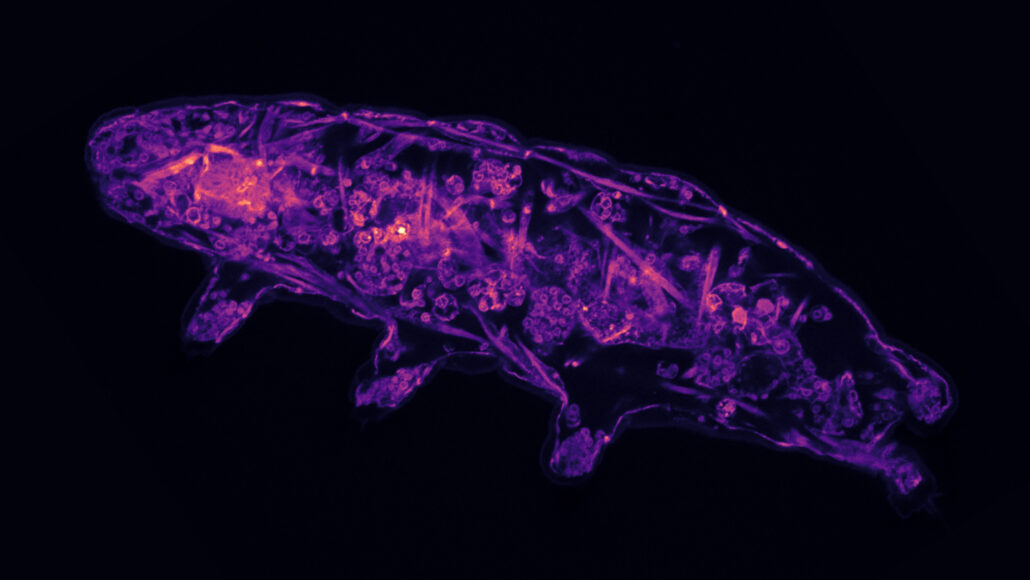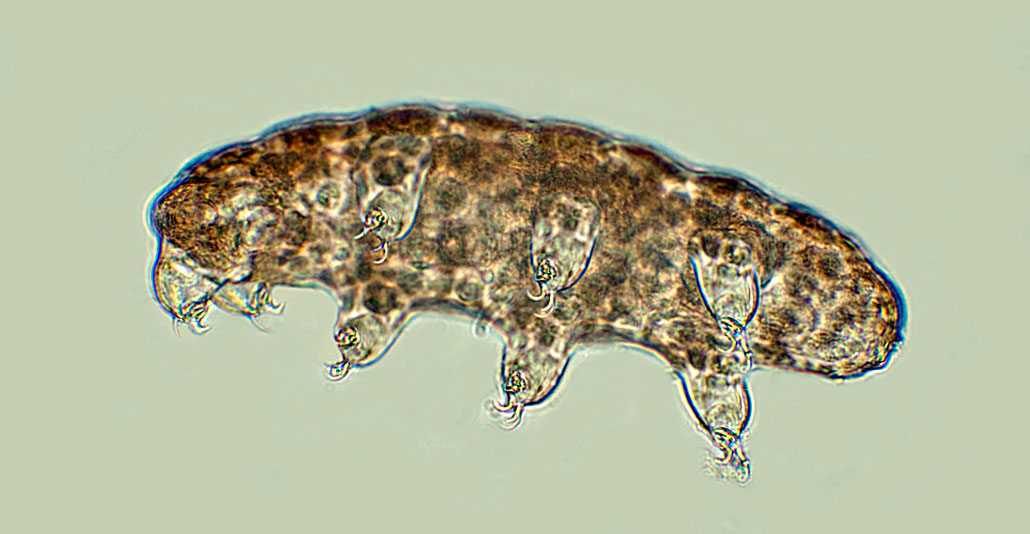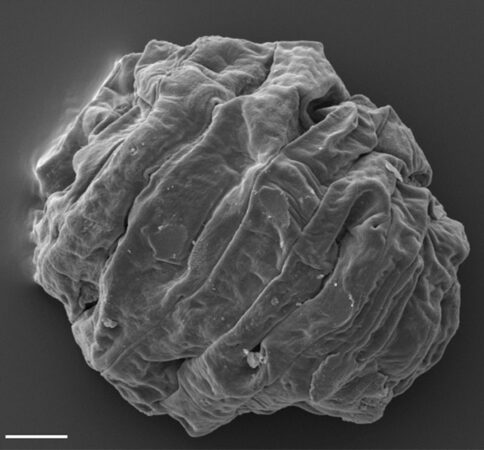Tardigrades survive harsh conditions by almost dying. Here’s how
Under stress, chemical changes signal these water bears to enter a dormant state

Tardigrades can go into a dormant state to survive extreme conditions. This tardigrade has been stained with a purple dye to show its internal organs. A chemical signal in the animal’s body can cause it to hunker down, then wake up again.
A.L. Smythers et al/ PLOS ONE 2024 (CC-BY 4.0)
When times get tough, tiny tardigrades have a special way to ride it out. They go into a dormant state. But it hasn’t been clear how these critters turn that superpower on and off. Now, researchers have an answer: A molecular sensor tells tardigrades it’s time to toughen up.
Tardigrades are microscopic, eight-legged animals. Also called water bears or moss piglets, they’re famous for their strange looks — and their ability to survive just about anything. Freezing. Drying out. X-rays. Even trips into space. When needed, tardigrades curl into a ball called a tun. They pull in their legs, get rid of all their water and turn their insides to glass.

When this happens, their normal body functions slow to a near standstill. In that state, tardigrades can withstand all types of extreme conditions.
But it’s been an open question as to what triggers tardigrades to go into or out of their tun state. At last, researchers pinpointed a chemical change that occurs within the animal’s proteins. They described the finding January 17 in PLoS One.
The project came about “on a whim,” says Derrick Kolling. He’s a chemist at Marshall University in Huntington, W.Va. His team had been studying how algae recover from damage and stress. Tardigrades are champions of dealing with stress. So studying them might show how to help stressed algae.
Also, “we were curious about tardigrades,” Kolling says. “They’ve been in the news quite a bit.” So he told his lab, “tardigrades are easy to get. Let’s get some and let’s put them in an instrument we have here.”
That instrument was one used to study unpaired electrons in atoms and molecules. Electrons usually exist in pairs. Unpaired electrons can make an atom or molecule unstable. That’s because unpaired electrons like to react with other molecules. You might have heard such chemicals called free radicals or oxidants.
The researchers analyzed tardigrades with the instrument. As the animals entered the tun state, their levels of superoxides (a type of oxidant) shot up. Superoxides are oxygen molecules hosting an extra electron. That extra electron primes superoxides to react with other atoms and molecules. Often, such reactions damage proteins and other parts of cells.
But superoxides can also be used to send signals, says Leslie Hicks. She’s a chemist at the University of North Carolina at Chapel Hill. Her lab teamed up with Kolling’s to study the tardigrades.
Do you have a science question? We can help!
Submit your question here, and we might answer it an upcoming issue of Science News Explores
Stressful situations
They decided to stress out the tardigrades and watch what happened. They used the chemical hydrogen peroxide, or H2O2. It’s very good at stealing electrons from other molecules, a process called oxidation. Water bears wouldn’t normally run into H2O2, so it was a good test of general stress.

“Let’s throw hydrogen peroxide at the bears and see if they can form tuns as a result of that stress,” Hicks remembers saying. The team exposed water bears to different mixtures of water and H2O2. Sure enough, these mixtures triggered tardigrades to go into tun mode. Removing the hydrogen peroxide woke up the water bears again.
That showed oxidation was an important signal for going in and out of the tun state.
Next, Hicks and her team explored what molecule was being oxidized. Cysteine (SIS-teen) is an amino acid, one of the 21 that make up proteins in living things. And this amino acid seemed important, their tests showed. Oxidizing chemicals such as H2O2 can change cysteine. Those changes, in turn, can alter the structure and activity of any protein it’s a part of.
The cysteine take-home
Hicks’ team tried stressing tardigrades with too much salt or sugar. At the same time, the researchers blocked cysteine oxidation. Now, the animals couldn’t form tuns.
And when unable to oxidize cysteine, the tardigrades also couldn’t survive freezing.
But tardigrades don’t form tuns when frozen. This means cysteine oxidation may be key to all of their survival tactics, Hicks says.
Kazuharu Arakawa studies tardigrades at Keio University in Fujisawa, Japan. Some tardigrades can tolerate drying without forming tuns. Arakawa wonders whether those species also need oxidation to survive. Hicks’ group didn’t test drying in this study, he notes.
The work by Hicks’ group helps explain some things about water bear biology, says Hans Ramløv. He is a comparative physiologist at Roskilde University in Denmark. He did not take part in the new study. Tardigrades’ body activities kick in at high rates when their tun state ends. They may need extra energy to reverse cysteine oxidation, he now suggests. They might also need it to repair damage caused by oxidation.
The cysteine data may also help guide studies of other creatures that go into suspended animation. That’s when the body’s chemical activities, or metabolism, drop to nothing and animals are just about dead.
But one big question remains, Ramløv notes. “It obviously does not explain how you can stop metabolism and die — [then] restart metabolism and live.”







